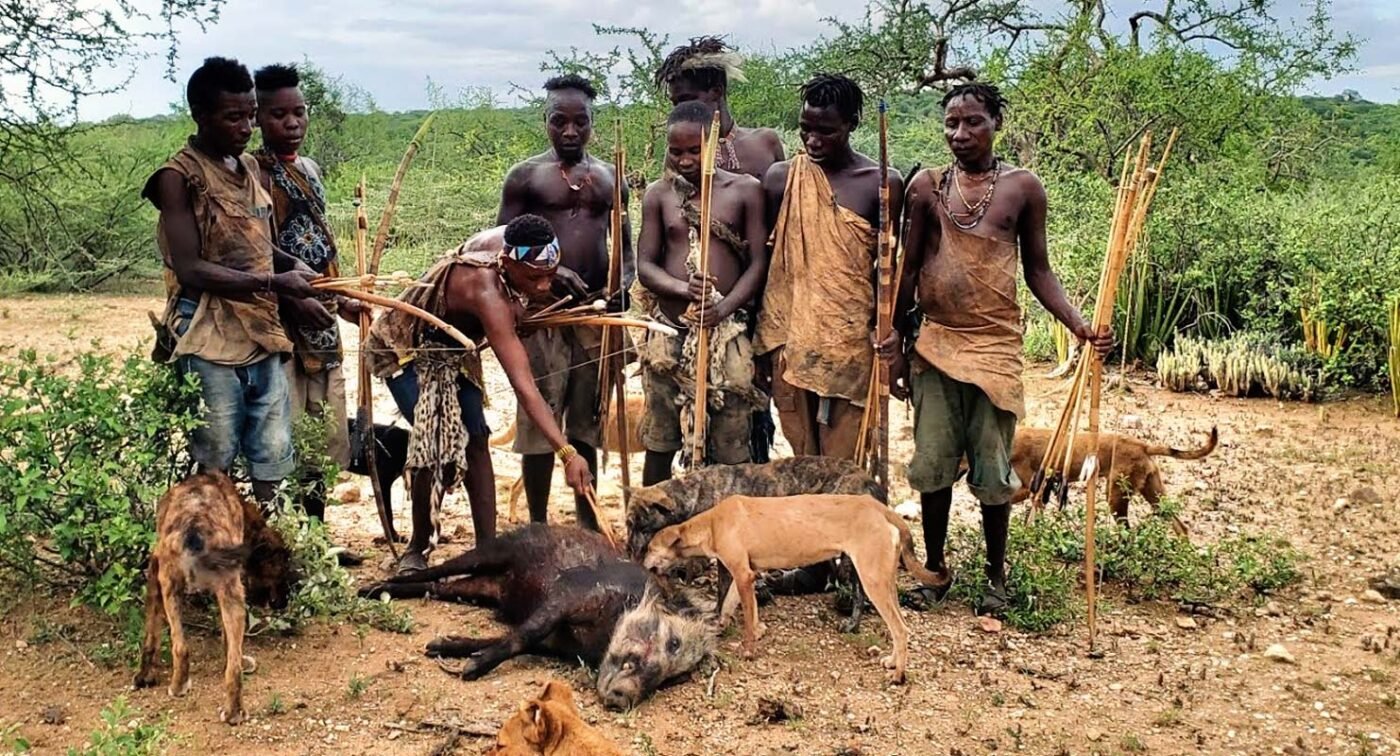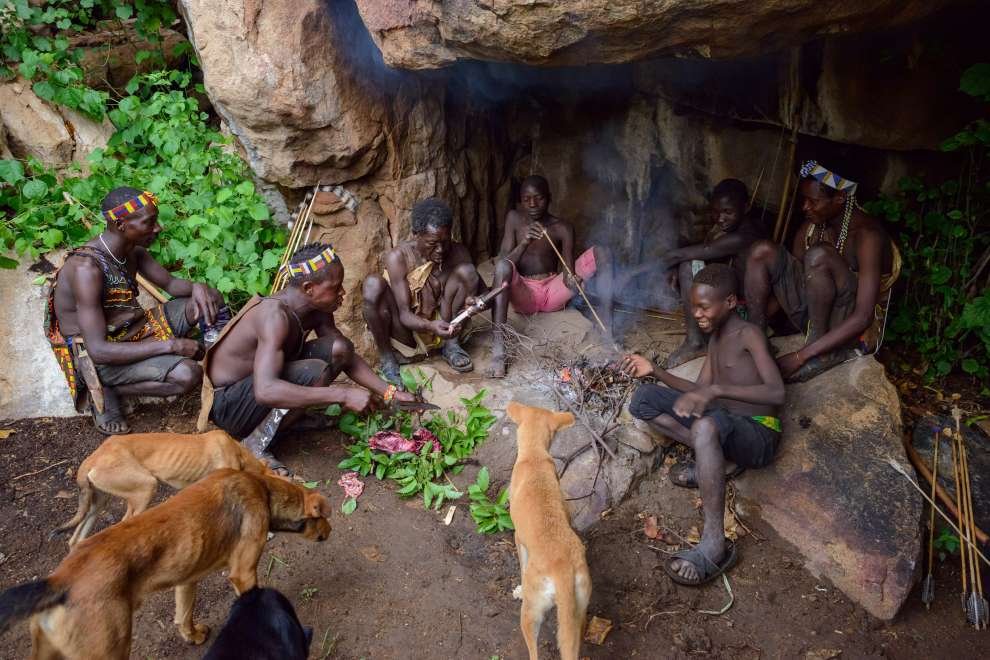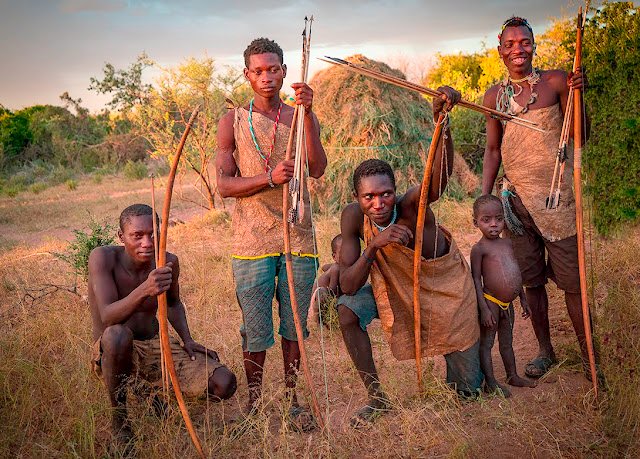The Hadza people are believed to be one of the oldest human populations on Earth. Genetic studies trace their ancestry back tens of thousands of years, offering a rare glimpse into the origins of Homo sapiens. The Hadza are nomadic, moving with the seasons and the availability of resources.
Hadza culture has no written language; instead, knowledge, history, and wisdom are passed down through storytelling. The Hadza live in small groups or bands, typically consisting of 10 to 30 individuals. Family is at the heart of Hadza society, fostering a deep sense of cooperation and communal living.
For the Hadza, nature is a living, breathing entity that must be respected and nurtured. They have developed a sustainable relationship with their environment, taking only what they need and ensuring that the ecosystem remains in balance.
Despite their remote location, the Hadza are not immune to the pressures of the modern world. Agricultural expansion, tourism, and land development have increasingly encroached on their traditional lands. Climate change is another major challenge, as shifting weather patterns affect the availability of resources.
The Hadza tribe represents a living window into humanity’s ancient past. Their connection with nature, their egalitarian social structure, and their enduring traditions offer a powerful example of how humans can live in harmony with the environment. However, the Hadza face increasing challenges from encroachment, climate change, and cultural assimilation.

The Hadzabe Tribe: Hidden deep in northern Tanzania, near the shimmering waters of Lake Eyasi, the Hadza tribe stands as one of the last living links to humanity’s ancient past. As one of the world’s last true hunter-gatherer societies, the Hadza have preserved a way of life that has remained largely unchanged for thousands of years. Their story is one of resilience, survival, and an intimate connection with nature. In this article, we take an in-depth look at the Hadza people—their culture, language, and way of life—and explore the challenges they face as modernity encroaches on their ancient traditions.
1. The Origins of the Hadza Tribe
1.1 An Ancient People
The Hadza people are believed to be one of the oldest human populations on Earth. Genetic studies trace their ancestry back tens of thousands of years, offering a rare glimpse into the origins of Homo sapiens. Living in the same region for millennia, they have developed an intimate understanding of their environment, passing down survival skills through countless generations.
1.2 A Nomadic Lifestyle
The Hadza are nomadic, moving with the seasons and the availability of resources. Unlike neighboring tribes that have transitioned to farming or herding, the Hadza remain true to their roots. Their diet is still based on wild game, edible plants, and honey gathered from their surroundings. This ability to adapt to the rhythms of nature is key to their survival, allowing them to live sustainably in an often harsh environment.
 The Hadza Tribe
The Hadza Tribe
2. Language: The Sound of an Ancient Tongue
2.1 The Click Language of the Hadza
One of the most distinctive features of Hadza culture is their language, known simply as Hadza or Hadzā. This language belongs to the click family, which uses clicking sounds alongside vowels and consonants. The Hadza’s language is not only unique but also a vital part of their identity, reflecting their deep connection to the past.
2.2 Preserving Tradition through Oral Stories
Hadza culture has no written language; instead, knowledge, history, and wisdom are passed down through storytelling. Elders share oral traditions that are rich with tales of ancestors, animals, and the land. These stories are more than entertainment—they carry essential survival information and cultural values, ensuring the next generation remains rooted in their heritage.
3. Social Structure: A Community in Harmony
3.1 Family and Kinship Bonds
The Hadza live in small groups or bands, typically consisting of 10 to 30 individuals, mostly extended family members. Family is at the heart of Hadza society, fostering a deep sense of cooperation and communal living. Kinship plays a crucial role in how resources are shared and how decisions are made.
3.2 Gender Roles: A Balanced Partnership
In Hadza society, men and women have distinct but equally vital roles. Men are hunters, skillfully tracking and taking down animals with handcrafted bows and arrows. Women are gatherers, collecting berries, tubers, and honey from the landscape. Despite this division of labor, Hadza society is highly egalitarian, with both men and women contributing to the group’s survival and decision-making.
3.3 Leadership without Hierarchy
Unlike many societies that have chiefs or kings, the Hadza have no formal leaders. Decisions are made collectively, and elders offer guidance based on experience. This informal and flexible system of governance reflects the Hadza’s communal way of life, where cooperation and shared responsibility are key.
 The Hadza Tribe
The Hadza Tribe
4. The Art of Hunting and Gathering
4.1 Hunting: A Timeless Skill
Hunting is not just a means of survival for the Hadza—it is an integral part of their identity. The men of the tribe are renowned hunters, using their expertise in tracking and their mastery of bows and arrows to hunt game such as antelope, birds, and even baboons.
4.1.1 Tools of the Trade
The Hadza’s weapons are crafted with precision. Their bows are made from local trees, while arrows are tipped with poison derived from desert plants, ensuring a swift and humane kill. This combination of natural materials and expert craftsmanship has been passed down through generations.
4.1.2 Teamwork in the Hunt
While Hadza men sometimes hunt solo, they also work in groups, particularly for larger game. This collective hunting not only increases the odds of success but also reinforces social bonds and ensures that the entire group shares in the rewards of the hunt.
4.2 Gathering: Sustenance from the Land
Gathering is equally important for the Hadza’s survival, and women play the lead role in this practice. They harvest tubers, berries, and honey, drawing on an extensive knowledge of edible plants and seasonal cycles. Their work provides the essential nutrition that balances the meat from hunting, creating a well-rounded diet.
5. Deep Connection to Nature
5.1 Guardians of the Ecosystem
For the Hadza, nature is not just a resource—it is a living, breathing entity that must be respected and nurtured. They have developed a sustainable relationship with their environment, taking only what they need and ensuring that the ecosystem remains in balance. This harmony with nature is a key reason why the Hadza have been able to survive in the same region for so long.
5.2 Seasonal Adaptation
The Hadza are experts at adapting to the seasonal changes of their environment. During the rainy season, plants are abundant, and game is easier to find. In the dry season, they move to areas where resources are more plentiful, relying on their deep knowledge of the land to guide them.
6. Spirituality and Worldview
6.1 Nature as a Spiritual Force
The Hadza tribe do not practice organized religion, but their spiritual beliefs are closely tied to the natural world. They believe that spirits reside in the animals, plants, and landscapes around them. This spiritual connection influences their respect for the environment and guides their actions, particularly in hunting and gathering.
6.2 Rituals of Gratitude
Before and after a successful hunt, the Hadza may perform rituals to honor the spirit of the animal. These rituals are simple but significant, reflecting the tribe’s belief that every living thing has a soul and must be treated with respect.
7. Modern Challenges
7.1 The Threat of Encroachment
Despite their remote location, the Hadza are not immune to the pressures of the modern world. Agricultural expansion, tourism, and land development have increasingly encroached on their traditional lands. As their territory shrinks, the Hadza’s ability to maintain their way of life is threatened.
7.2 Climate Change and Its Impact
Climate change is another major challenge, as shifting weather patterns affect the availability of resources. Prolonged droughts and erratic rainfall make it more difficult for the Hadza to find food, forcing them to adapt to conditions that are becoming increasingly unpredictable.
7.3 Cultural Assimilation
As the outside world continues to influence the region, younger Hadza are exposed to modern technologies, education, and ways of life. While this offers new opportunities, it also poses a risk to the preservation of the Hadza’s language, traditions, and identity.
8. Efforts to Protect the Hadza Culture
8.1 Conservation and Advocacy
Various organizations are working to protect the Hadza’s land rights and cultural heritage. These efforts include legal support to secure land titles, as well as initiatives that promote sustainable practices and respect for indigenous knowledge.
8.2 Eco-Tourism: A Path to Sustainability
Eco-tourism offers a potential solution to some of the challenges facing the Hadza. By inviting small groups of tourists to experience their culture firsthand, the Hadza can generate income while educating visitors about their way of life. However, it is essential that tourism is managed in a way that respects their privacy and does not disrupt their lifestyle.
8.3 Education and Empowerment
Empowering the Hadza to advocate for their own rights is key to ensuring their survival. This includes providing access to education that allows them to engage with the modern world on their own terms, while still preserving their cultural heritage.
 The Hadza Tribe
The Hadza Tribe
Conclusion
The Hadza tribe represents a living window into humanity’s ancient past. Their profound connection with nature, their egalitarian social structure, and their enduring traditions offer a powerful example of how humans can live in harmony with the environment. However, the Hadza face increasing challenges from encroachment, climate change, and cultural assimilation. Protecting their way of life is not only about preserving one of the world’s last hunter-gatherer societies—it is also about safeguarding a way of life that holds valuable lessons for the modern world.
As we strive to understand and address the complex issues facing our planet, we can learn from the Hadza’s resilience, adaptability, and deep respect for the natural world. By supporting their rights and promoting sustainable practices, we can help ensure that this ancient culture continues to thrive in the face of modern challenges.lp ensure that this ancient culture endures for future generations. The Hadza tribe not only exemplifies the diversity of human cultures but also serves as a reminder of the importance of living in harmony with nature.
